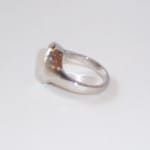White Gold Ring Featuring a Classical Revival Carnelian Intaglio of a Scorpion, 18th Century CE - 19th Century CE
Carnelian, Gold
FJ.6820 B
Further images
This Gorgeous Intaglio Has Been Set in a Modern 18 Karat White Gold Rin The art of glyptics, or carving on colored precious stones, is probably one of the oldest...
This Gorgeous Intaglio Has Been Set in a Modern 18 Karat White Gold Rin
The art of glyptics, or carving on colored precious stones, is probably one of the oldest known to humanity. Intaglios, gems with an incised design, were made as early as the fourth and third millennia B.C. in Mesopotamia and the Aegean Islands. They exhibit a virtuosity of execution that suggests an old and stable tradition rooted in the earliest centuries. The tools required for carving gems were simple: a wheel with a belt-drive and a set of drills. A special difficulty of engraving intaglios, aside from their miniature size, was that the master had to work with a mirror-image in mind.
The Classical Revival was a phenomenon that swept through Europe in the 18th and 19th Centuries. A new appreciation for antiquity and ancient art forms was fostered by discoveries in the nascent scientific field of archaeology. Perhaps the Classical Revival also reveals a latent longing towards the Arcadian lifestyles of yesterday abandoned as Europe became rapidly industrialized and increasingly urbanized. Engraved upon the polished surface of this precious gemstone is a depiction of a scorpion. This remarkable creature is both a source of fear and revelry. Related to spiders, scorpions are abhorred for their venomous stingers housed on the tip of their characteristically coiled, segmented tails. Much for the same reasons they are so feared, scorpions are also respected and revered. Throughout history, civilizations such as the Egyptians and Sumerians have worshiped composite scorpion/human deities. Even today if you read the astrology section of the newspaper, you’ll find this ancient creature. For many, placing this gorgeous ring on our finger is as close as we want to get to this fascinating creature that has inspired man since the dawn of civilization.
The art of glyptics, or carving on colored precious stones, is probably one of the oldest known to humanity. Intaglios, gems with an incised design, were made as early as the fourth and third millennia B.C. in Mesopotamia and the Aegean Islands. They exhibit a virtuosity of execution that suggests an old and stable tradition rooted in the earliest centuries. The tools required for carving gems were simple: a wheel with a belt-drive and a set of drills. A special difficulty of engraving intaglios, aside from their miniature size, was that the master had to work with a mirror-image in mind.
The Classical Revival was a phenomenon that swept through Europe in the 18th and 19th Centuries. A new appreciation for antiquity and ancient art forms was fostered by discoveries in the nascent scientific field of archaeology. Perhaps the Classical Revival also reveals a latent longing towards the Arcadian lifestyles of yesterday abandoned as Europe became rapidly industrialized and increasingly urbanized. Engraved upon the polished surface of this precious gemstone is a depiction of a scorpion. This remarkable creature is both a source of fear and revelry. Related to spiders, scorpions are abhorred for their venomous stingers housed on the tip of their characteristically coiled, segmented tails. Much for the same reasons they are so feared, scorpions are also respected and revered. Throughout history, civilizations such as the Egyptians and Sumerians have worshiped composite scorpion/human deities. Even today if you read the astrology section of the newspaper, you’ll find this ancient creature. For many, placing this gorgeous ring on our finger is as close as we want to get to this fascinating creature that has inspired man since the dawn of civilization.





